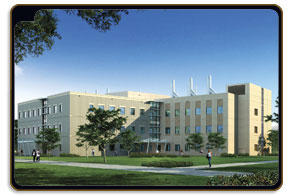Texas A&M University
The Coast Is Clear: World-Class Research and Teaching Await in Texas A&M at Galveston�s New Ocean and Coastal Studies Building
By Keith Randall

The new $53 million Ocean and Coastal Studies Building is the largest building project ever on the TAMUG campus. It will enable all of the school�s faculty and researchers to be housed in the same facility for the first time.
Texas A&M University at Galveston�s new Ocean and Coastal Studies Building is a literal sea change for facilities on the campus and at $53 million, $13 million of which was funded by PUF bond proceeds, it is by far the largest construction project ever at the school.
The building represents a commitment to research, teaching and service, says William C. Hearn, acting vice president and CEO of TAMUG. The 104,000-square foot facility will offer state-of-the-art classrooms, labs and offices, plus a lecture theater and a unique Sea Life Center that will enable researchers to bring in marine life directly from the Gulf of Mexico for immediate testing and analysis.
Serving as Texas A&M University�s ocean-oriented campus, TAMUG offers a unique blend of marine and maritime programs, including majors in science, business, engineering, and transportation to its approximately 2,000 students who receive hands-on experiences that complement their academic studies. With the Gulf of Mexico at its back door, the school has always emphasized the relationship between the university and the sea.
In addition, the island atmosphere of the campus enables students, staff and faculty to enjoy the academic and recreational aspects of coastal life, and the new Ocean and Coastal Studies Building will enhance the learning experience for all Sea Aggies.
�It will be the crown jewel of our campus,� says Hearn, who has been associated with the Galveston campus for more than 35 years. �It will allow us to have our researchers on the same campus for the first time in the school�s history.�
For decades, many of the school�s researchers were housed at the Fort Crockett campus, located a few miles from the main TAMUG facilities. Fort Crockett was originally built as an Army barracks in 1934 but in recent years it became obvious that age was quickly catching up with the building.
Texas A&M President R. Bowen Loftin, former head of the Galveston campus, says the new building will be one of historic importance. �It will allow us to unify our research on the Galveston campus,� Loftin says. �It is part of the original vision that George Mitchell had when he donated the land on the Pelican Island campus decades ago. Texas A&M will now have a greater role than ever in marine sciences.�
The new science building will bring together many of the region�s top marine biologists and marine scientists under one roof, says Brad McGonagle, assistant vice president of administration. �It will be the centerpiece of our main campus and I know visitors will be very impressed,� he says. �I don�t think you can find a better marine science facility in this part of the country.�
�It will be a great recruiting tool for both students and faculty,� Hearn adds. �It will allow us to expand our research efforts and also to attract new faculty. It will truly be a world-class facility. We are deeply appreciative of the work done by our state legislature and our Board of Regents. Both groups saw the need for this facility and the impact it could have for the future of Texas, and we are indebted to them for making this project happen.�
Dedication ceremonies for the new building are set for Nov. 11, 2010.